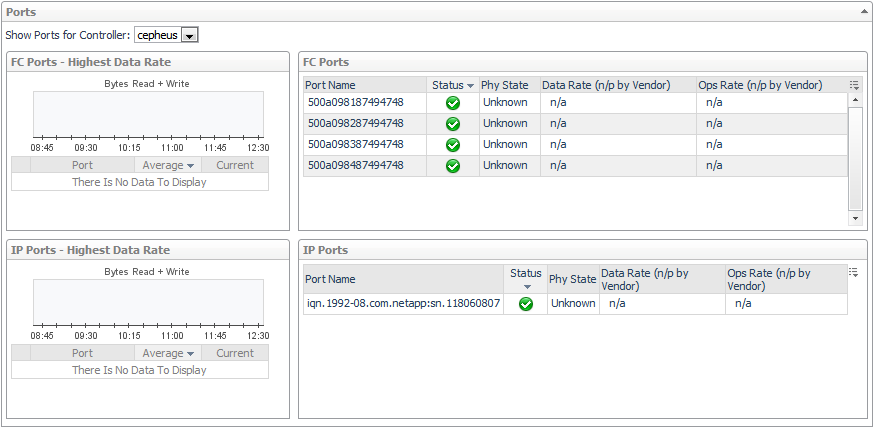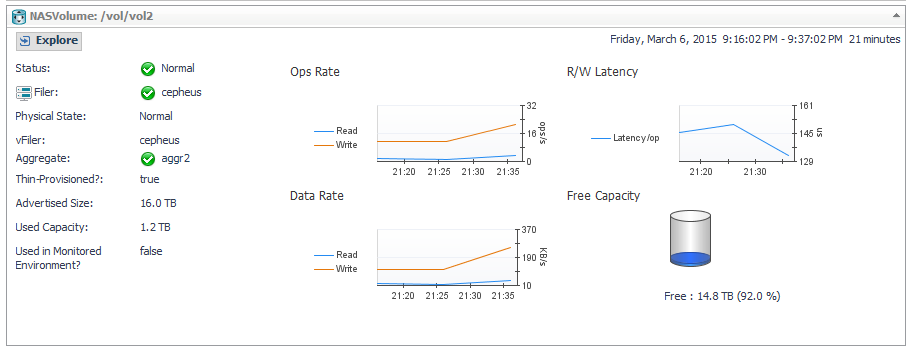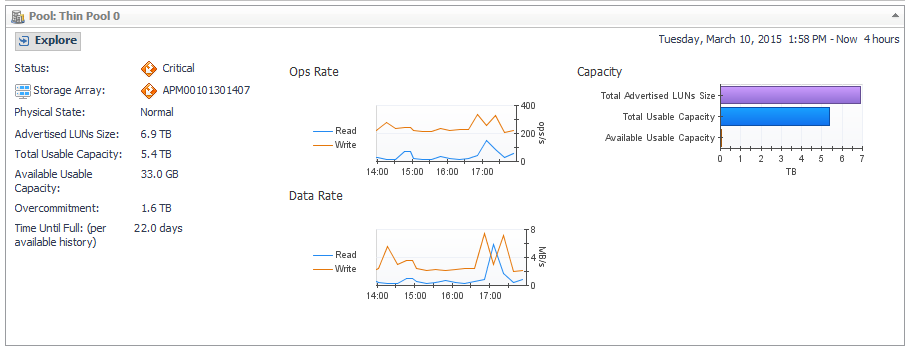Exploring a Cisco VSAN
|
1 |
On the navigation panel, under Dashboards, click Storage & SAN > Storage Explorer. |
|
2 |
On the navigation panel, under Topology, expand Fabrics, expand a Cisco fabric with VSANs, and select a VSAN. |
|
3 |
If the Alarm Count displays alarms, you may want to assess the alarms before continuing with this walkthrough. Click a status count to open a list of device and component alarms. For more information, see Assessing Storage Alarms. |
|
4 |
In the Summary tab, review performance in terms of key metrics. |
|
5 |
Click the ISL Ports tab. |
|
6 |
Click the N Ports tab. |
Exploring a Filer
Foglight for Storage Management supports NetApp filers. NetApp uses the word aggregate instead of pool, but the metrics collected for aggregates and pools are similar. In some filer views, in particular the views on the LUNs tab and Disks tabs, the word pool may be displayed instead of aggregate, but in this context it refers to aggregates.
|
1 |
On the navigation panel, under Dashboards, click Storage & SAN > Storage Explorer. |
|
2 |
On the navigation panel, under Topology, expand Filers and select a filer. |
|
3 |
In the Summary tab, review performance in terms of key metrics. |
|
• |
Summary and Resource Information. Displays physical details about the filer. |
|
• |
Alarm Summary. Displays alarms on the filer. |
|
4 |
Click the Controllers-Ports tab. |
|
• |
Controllers. The charts display the controllers with the highest average Data Rate and Ops Rate. The table displays current values for each of the charted metrics, plus Latency by block and file and the most severe alarm status on the FC ports and IP ports associated with this controller. |
|
• |
Ports. Select a controller from the Show Ports for Controller list. The ports associated with the selected controller are displayed, however the port’s physical state and performance metrics are unavailable for NetApp filers. The IP ports shown are used for iSCSI I/O to LUNs traffic. |
|
• |
Alarm Summary. Displays alarms on controllers and ports. |
|
6 |
Click the Aggregates tab. |
|
• |
Lowest Available Capacity. Displays the five aggregates with the lowest average value for Available Usable Capacity over the time period. |
|
• |
Most Overcommitted Aggregates. Identifies up to five of the most overcommitted aggregates, and displays current values for Advertised NASVolumes Size, Total Usable Capacity, and Used Capacity. |
|
• |
Aggregate Details. For each aggregate, displays the aggregate name, status, and current values for Total Usable Capacity, Available Usable Capacity, % Available, Advertised NASVolumes Size, and Overcommitment. |
|
• |
Alarm Summary. Displays alarms on aggregates. |
|
7 |
Click the NASVolumes tab. |
Exploring a Storage Array
The tabs displayed on the dashboard differ depending on the selected storage array:
|
• |
Non-Clustered Storage Arrays (supported storage arrays except EqualLogic and Isilon) |
Non-Clustered Storage Arrays
Most supported storage arrays are displayed as described in this walkthrough. If you are using Dell EqualLogic arrays, EMC Isilon arrays, or EMC VPLEX arrays, see Dell EqualLogic Storage Array, EMC Isilon Storage Array, or EMC VPLEX Storage Array instead.
|
1 |
On the navigation panel, under Dashboards, click Storage & SAN > Storage Explorer. |
|
2 |
On the navigation panel, under Topology, expand Storage Arrays and select a storage array. |
|
3 |
If the Alarm Count displays alarms, you may want to assess the alarms before continuing with this walkthrough. Click a status count to open a list of device and component alarms. For more information, see Assessing Storage Alarms. |
|
4 |
In the Summary tab, review performance in terms of key metrics. |
|
• |
Summary and Resource Information. Displays physical details about the storage array. |
|
• |
Alarm Summary. Displays alarms on the storage array. |
|
5 |
Click the Controllers-Ports tab. |
|
• |
Controllers. The charts display the controllers with the highest average Data Rate, Ops Rate, and % Busy, if available. The table displays current values for each of the charted metrics, plus Latency if available, and the most severe alarm status on the FC ports and IP ports associated with this controller. |
|
• |
Ports. Select a controller from the Show Ports for Controller list. The chart will display port utilization distribution, if the array provides the operating link speed of the ports. Otherwise, the Data Rate of the 3 busiest ports will be displayed. The tables will display all available current metrics for each port. |
|
6 |
Click the Pools tab. |
|
• |
Show Top 15/All Pools/Pools w Thin LUNs With … This view lets you quickly see the top fifteen or all LUNs with a selected metric, averaged over the selected time period. The performance metrics that may be available for selection, depending on the array type, include: |
|
NOTE: Selecting Pools w Thin LUNs is useful for monitoring Pools whose available capacity can change quickly because it contains thin-provisioned LUNs. |
|
• |
Alarm Summary. Displays alarms on pools. |
|
9 |
Click the Advanced Find tab to investigate a LUN or Disk that is not included in the Top 15 items on the LUNs or Disks. Use the Advanced Find functionality to query for the desired items. For more information, see Advanced Find. |







